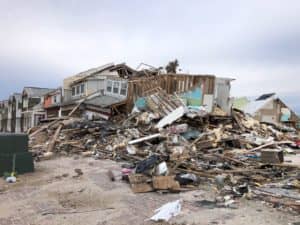Documentary director hopes to help save lives and property from catastrophic storms
A new documentary film provides an in-depth and intimate look into the personal and community costs that face the nation’s most vulnerable areas to extreme weather events if more stringent building codes are not adopted – and the Tampa Bay area is one of them.
The Last House Standing examines the Malibu wildfires of 2018, a series of catastrophic tornadoes in Moore, Oklahoma in 2013, and Hurricane Michael’s devastation of Mexico Beach and the Florida Panhandle in 2018. Tampa and St. Petersburg are also prominently featured in the film – as areas that are woefully unprepared for major storms and climate change.
Director George Siegal began his career as a weathercaster and then spent 14 years as a TV morning show host, and told the Catalyst he was constantly covering places ravaged by disasters.
“It’s always the same story, different victim, and always sad,” he said. “Some of it was avoidable, usually from a lack of preparation or expectations that something bad could happen.”
Siegal left the news business and knew he wanted to make a film like this one, and when he saw the actual last house standing on Mexico Beach in the aftermath of Hurricane Michael, he found his center point for the documentary.
“It jumped out to me that this is a metaphor for what we’re talking about – you want to survive the storm,” said Siegal.
The house in Mexico Beach was the only structure left intact amid a sea of destruction because the owner, Dr. Lebron Lackey, exceeded code requirements in building a storm-resistant home. Mexico Beach has a relatively stringent requirement that new buildings must withstand 120-150 mph winds, but Hurricane Michael went from a Category 1 to a Category 4 storm in just four days and made landfall as a Category 5 with sustained winds of 162 mph.
Lackey’s home was built to withstand sustained winds of 250 mph and was elevated far above code height requirements. Spending a little extra money on the construction of his home saved Lackey’s and his uncle’s lives that day.
Siegal would like residents around the bay to realize strengthening their homes and proper hurricane preparation could save their lives. The director moved to Tampa in 2017 and was dismayed by the apathy towards these increasingly powerful storms that many locals possess.
“I didn’t get the sense that people worry that much about it, and I still don’t,” said Siegal. “Nobody thinks it’s going to happen to them.”

Sean Sullivan, Executive Director of the Tampa Bay Regional Planning Council (TBRPC), also played a key role in the making of The Last House Standing. He relayed a quote from Pinellas County Commissioner Janet Long that has stuck with him, and was used in the movie.
“Living in the Tampa Bay region, we truly live in paradise, but with living in paradise comes great responsibility,” said Long.
Sullivan said that multiple studies have shown that the Tampa Bay region is one of the most vulnerable to storm surge and extreme weather, not just in the country but the world. The documentary showed that simple solutions such as hurricane windows, reinforced garage doors and exceeding existing building codes could be the difference between losing your home or your life. Having proper insurance and understanding what is covered also plays a key role in ensuring someone can rebuild after the dust has settled.
Sullivan and Siegal both want to see local governments partner with the private sector to achieve a common goal, which is saving property and lives. They realize anytime something costs a little more there is reluctance, but the costs after a severe weather event will always be greater.
The TBRPC, which pulls 27 local governments together, participated in the film to increase awareness of the potential for extreme weather and show how vulnerable the area is to these storms. Sullivan mentioned that the St. Pete tide gauge shows a seven-inch sea level increase since 1954. The TBRPC collects information and then formulates a course of action that best protects the communities it serves.
“We kind of lay out a menu of options for governments to think about,” said Sullivan. “We help bring them together to collectively discuss what these options are and what options they can choose that will work best in their city.”
“We have to raise the awareness that climate change is real, extreme weather events are real, and governments need to think about taking a look at both their zoning and building codes.”
Siegal’s documentary has won three awards of excellence and a humanitarian award on the film festival circuit so far, but the director said it is not about making money or the accolades. He wants it to be a wakeup call for people to protect themselves from becoming a victim. He said the reward is that the film makes a difference.
“Go back and look at every disaster and look at the poor folks that are wiped out every time,” said Siegal. “It’s just a different tragedy in a different place, but it’s the same story – ‘we never thought it would happen.’”
To stream The Last House Standing, visit thelasthousestanding.org.
The Project Phoenix 2.0 simulation that shows how a major hurricane could devastate the area can be viewed here.








David Kiser
October 9, 2021at10:46 am
As a lifelong resident of Mexico Beach it pains me to see someone use incorrect information for their personal gain.That was not the only house left standing just the only one in that small area of MB which mainly consisted of small block homes build in the 1950s and 60s.Also Hurricane Michael was a cat 5 not a cat 4 .Get your facts right .